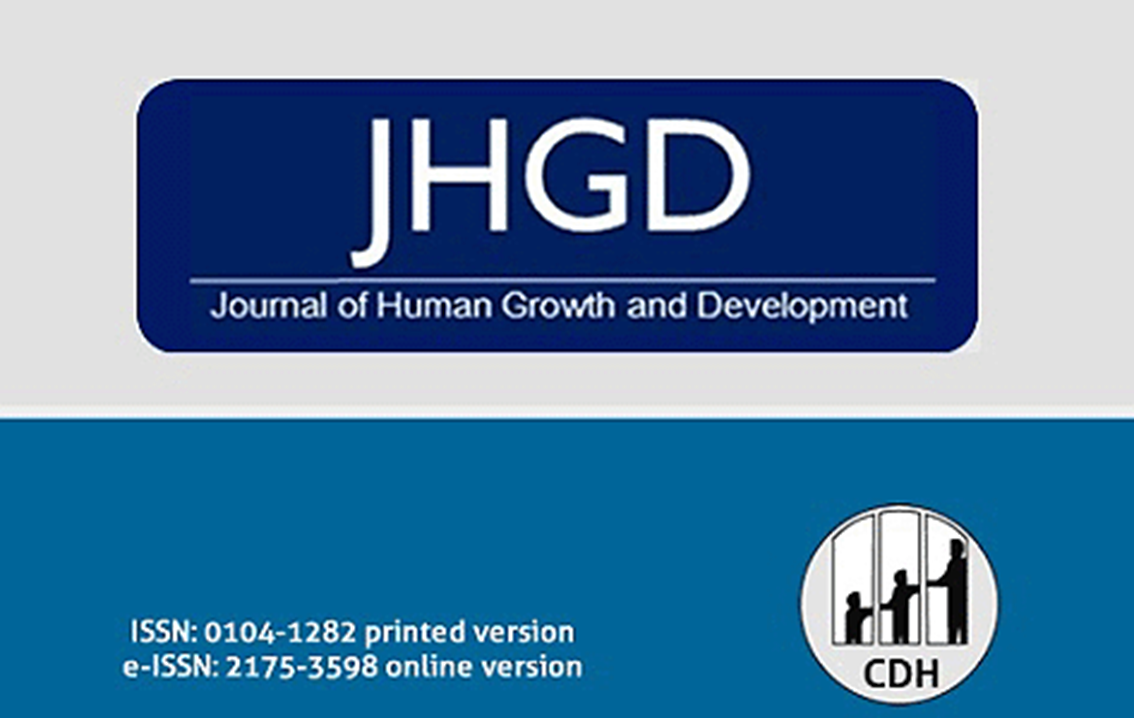Brazilian girls who practice classical ballet develop different motor strategies regarding postural stability
DOI:
https://doi.org/10.7322/jhgd.v30.9973Keywords:
Child development, Postural balanc, DanceAbstract
Introduction: The growth and development of children is a product of the interaction of biological and
environmental factors. Dance practice can optimize various aspects of motor control, coordination and
balance in childhood and adolescence.
Objective: The objective of the present study was to verify how the practice of classical ballet, at a professional level, can influence the plantar pressures and balance of children and adolescents, as well as to verify if subjects’ vision and posture of the upper limbs can interfere in this result.
Methods: Cross-sectional study performed with 111 girls aged 10 to 15 years who practice classical ballet (n = 56) and non-dancers (n = 55). Anthropometry (BMI), plantar pressures and postural stability (baropodometry platform) were assessed. Three different conditions: eyes open (EO), eyes closed (EC) and arms outstretched (AO) were observed. Data analysis performed by using group comparison and correlation tests.
Results: Those who practiced classical ballet placed less weight onto the left forefoot, presented lower values of maximum pressure and plantar surface area in all the evaluated conditions and moved less in the stabilometry analysis. It also observed that ballet dancers were more influenced by vision and positioning of the upper limbs than the group of non-dancers. Length of time as a dancer influenced the results found.
Conclusions: Girls who practice classical ballet have specific characteristics of plantar pressure and develop different postural control strategies when compared to typical girls of similar age, especially in the arms outstretch position.
Downloads
References
2. Pérez RM, Solana RS, Murillo DB, Hernández FJM. Visual availability, balance performance and movement complexity in dancers. Gait Posture. 2014;40(4):556-60. DOI: http://doi.org/10.1016/j.gaitpost.2014.06.021
3. Costa MSS, Ferreira AS, Felicio LR. Static and dynamic balance in balé dancers: a literature review. Fisioter Pesqui. 2013;20(3):299-305. DOI: https://doi.org/10.1590/S1809-29502013000300016
4. Cheng HS, Law CL, Pan HF, Hsiao YP, Hu JH, Chuang FK, et al. Preliminary results of dancing exercise on postural stability in adolescent females. Kaohsiung J Med Sci. 2011;27(12): 566-72. DOI: https://doi.org/10.1016/j.kjms.2011.06.032
5. Michalska J, Kamieniarz A, Fredyk A, Bacik B, Juras G, Stomka KJ. Effect of expertise in balé dance on static and functional balance. Gait Posture. 2018;64:68-74. DOI: https://doi.org/10.1016/j.gaitpost.2018.05.034
6. Rein S, Fabian T, Zwipp H, Rammelt S, Weindel S. Postural control and functional ankle stability in professional and amateur dancers. Clin Neurophysiol. 2011;122(8): 1602-10. DOI: https://doi.org/10.1016/j.clinph.2011.01.004
7. Casabona A, Leonardi G, Aimola E, La Grua G, Polizzi CM, Cioni M, et al. Specificity of foot configuration during bipedal stance in balé dancers. Gait Posture. 2016;46:91-7. DOI: https://doi.org/10.1016/j.gaitpost.2016.02.019
8. Bruyneel AV, Bertrand M, Mesure S. Influence of foot position and vision on dynamic postural strategies during the “grand plié” balé movement (squatting) in young and adult balé dancers. Neurosci Lett. 2018;678:22-8. DOI: https://doi.org/10.1016/j.neulet.2018.04.046
9. Hutt K, Redding E. The effect of an eyes-closed dance-specific training program on dynamic balance in elite pre-professional balé dancers: a randomized controlled pilot study. J Danc Med Sci. 2014;18(1):3-11. DOI: https://doi.org/10.12678/1089-313X.18.1.3
10. van Emmerik REA, van Wegen EEH. On the functional aspects of variability in postural control. Exerc Sport Sci Rev. 2002;30(4):177-83. DOI: https://doi.org/10.1097/00003677-200210000-00007
11. van Emmerik REA, van Wegen EEH. On Variability and Stability in Human Movement. J Appl Biomech. 2000;16: 394–406. DOI: https://doi.org/10.1123/jab.16.4.394
12. Giacomozzi C. Hardware performance assessment recommendations and tools for baropodometric sensor systems. Ann Ist Super Sanità. 2010;46(2):158-67. DOI: https://doi.org/10.4415/ANN_10_02_09
13. Orlin MN, McPoil TG. Plantar Pressure Assessment. Phys Ther. 2000;80(4):399-409. DOI: https://doi.org/10.1093/ptj/80.4.399
14. Filippin NT, Barbosa VLP, Sacco ICN, Costa PHL. Effects of obesity on plantar pressure distribution in children. Rev Bras Fisioter. 2007;11(6):495-501. DOI: http://doi.org/10.1590/S1413-35552007000600012
15. Staheli LT, Chew DE, Corbett M. The longitudinal arch. A survey of eight hundred and eight-two feet in normal children and adults. J Bone Joint Surg Am. 1987;69(3): 426-8.
16. Syed N, Karvannan H, Maiya AG, Binukumar B, Prem V, Chakravarty RD. Plantar pressure distribution among asymptomatic individuals: a cross-sectional study. Foot Ankle Spec. 2012;5(2):102-6. DOI: http://doi.org/10.1177/1938640011434503
17. Cavanagh PR, Rodgers MM, Liboshi A. Pressure distribution under symptom-free feet during barefoot standing. Foot Ankle Int. 1987;7(5):262-76. DOI: http://doi.org/10.1177/107110078700700502
18. Buldt AK, Forghany S, Landorf KB, Levinger P, Murley GS, Menz HB. Foot posture is associated with plantar pressure during gait: A comparison of normal, planus and cavus feet. Gait Posture. 2018;62:235-40. DOI: http://doi.org/10.1016/j.gaitpost.2018.03.005
19. Burns J, Crosbie J, Hunt A, Ouvrier R. The effect of pes cavus on foot pain and plantar pressure. Clin Biomech. 2005;20(9):877–82. DOI: http://doi.org/10.1016/j.clinbiomech.2005(9).03.006
20. Rosenbaum AJ, Lisella J, Patel N, Phillips N. The cavus foot. Med Clin North Am. 2014;98(2):301-12. DOI: http://doi.org/10.1016/j.mcna.2013.10.008
21. Costa PHL, Nora FGA, Vieira MF, Bosch K, Rosenbaum D. Single leg balancing in balé: Effects of shoe conditions and poses. Gait Posture. 2013;37(3:419-23. DOI: http://doi.org/10.1016/j.gaitpost.2012.08.015
22. Lin CW, Su FC, Wu HW, Lin CF. Effects of leg dominance on performance of balé turns (pirouettes) by experienced and novice dancers. J Sport Sci. 2013;31(16):1781-8. DOI: http://doi.org/10.1080/02640414.2013.803585
23. Kilby MC, Newell KM. Intra- and inter-foot coordination in quiet standing: Footwear and posture effects. Gait Posture. 2012;35(3):511-16. DOI: http://doi.org/10.1016/j.gaitpost.2011.11.018
24. Ku PX, Osman NAA, Yusof A, Abas WAW. Biomechanical evaluation of the relationship between postural control and body mass index. J Biomech. 2012;45(9): 1638-42. DOI: http://doi.org/10.1016/j.jbiomech.2012.03.029
25. Gautier G, Thouvarecq R, Larue J. Influence of experience on postural control: effect of expertise in gymnastics. J Mot Behav. 2008;40(5):400-8. DOI: http://doi.org/10.3200/JMBR.40.5.400-408
26. Juras G, Rzepko M, Król P, Czarny W, Bajorek W, Stomka K, et al. The effect of expertise in karate on postural control in quiet standing. Arch Budo Sci. 2013;9(3):205-9.
27. Latash ML. The bliss (not the problem) of motor abundance (not redundancy). Exp Brain Res. 2012;217(1): 1-5. DOI: http://doi.org/10.1007/s00221-012-3000-4
28. Mello MC, Ferreira AS, Felicio LR. Postural control during different unipodal positions in professional balé dancers. J Danc Med Sci. 2017;21(4):151-5. DOI: http://doi.org/10.12678/1089-313X.21.4.151
29. Hopper DM, Grisbrook TL, Newnham PJ, Edwards DJ. The effects of vestibular stimulation and fatigue on postural control in classical balé dancers. J Danc Med Sci. 2014;18(2):67-73. DOI: http://doi.org/10.12678/1089-313X.18.2.67






